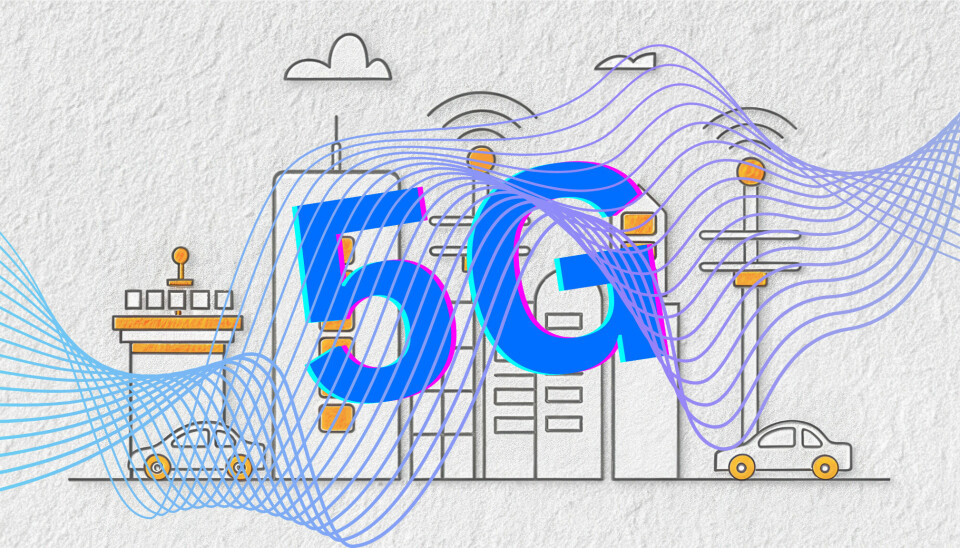Smart Factory

Visibility through invisible connections: How 5G is weaving a new automotive network
Automotive OEMs are embracing private 5G networks to drive digital twins, automation and AI. This shift enables safer, smarter and faster factories built on low-latency, high-security wireless connectivity.
Automotive OEMs are embracing 5G networks to drive digital twins, automation and AI. This shift enables safer, smarter and faster factories built on low-latency, high-security wireless connectivity.
As vehicles grow smarter and electric, and customisation demands intensify, the factory floor is becoming a fully "connected" enterprise. At the heart of this transformation lies 5G technology, its high-speed radio waves promising unprecedented levels of visibility, efficiency, and flexibility. But 5G is more than a mere speed bump for automotive manufacturing; it represents a lightning-fast, ultra-reliable nervous system that unveils truly intelligent factory floors; orchestrating real-time robotic ballet, enabling predictive maintenance with pinpoint accuracy, and fuelling instantaneous data streams for unparalleled production precision and efficiency.

The promise of 5G: a dedicated digital backbone for vehicle production
Automotive manufacturers worldwide are keenly focused on boosting productivity, enhancing worker safety, and championing sustainability. This pursuit, as Stephane Daeuble, Head of Enterprise Campus Edge Solutions proposition and market development at Nokia, aptly observes, often begins with a fundamental re-evaluation of connectivity.
"This shift often begins with the deployment of private wireless to ensure consistent and reliable wireless connectivity, for all of the plant’s unconnected assets." Traditional Wi-Fi, while ubiquitous, frequently falters under the sheer density of devices, the mission-critical low latency requirements, and the iron-clad security demanded by industrial environments.
This is precisely where private 5G – a dedicated, custom-built cellular network within a factory or campus – steps forward as a compelling alternative, providing "more dependable and higher-performing solutions than traditional Wi-Fi to support business and mission-critical use cases."

Indeed, Nokia itself has been at the forefront of this new industrial revolution. At Volkswagen's sprawling main plant in Wolfsburg, Germany, Nokia deployed a private 5G standalone network, operating in a dedicated spectrum band. This formidable network is an active laboratory designed to test and implement cutting-edge smart factory applications, from the wireless upload of colossal data packages directly to vehicles on the line to the intelligent networking of thousands of robots and precision assembly tools.
Similarly, in Japan, Nokia joined forces with Toyota Production Engineering and local systems integrator NS Solutions (NSSOL) to establish an industrial-grade private wireless network at Toyota's manufacturing design centre in Fukuoka. The project aims to assess the potential of private wireless for designing innovative production processes, pushing the boundaries of what's possible in automotive manufacturing. The advantages of such deployments are various and far-reaching.
Private 5G networks deliver ultra-low latency (often as low as 1 millisecond), enable massive connectivity capacity (supporting millions of devices per sq. km), boast high bandwidth, and offer unparalleled reliability and security.
This deterministic connectivity allows manufacturers to maintain complete control over their proprietary data, guarantee quality of service, and isolate sensitive operational technology (OT) data from the public internet. Such robust, tailored connectivity is the very bedrock upon which the smart factory of tomorrow is being meticulously constructed.
Use cases in motion and real-world applications
Empowering the connected worker
For too long, frontline workers have operated with limited access to real-time information. Private wireless bridges this critical gap. "Private wireless allows connectivity for all frontline workers with rugged industrial devices – like tablets, or smartphones – to support hands-free communication, and empower workers with the information they need anywhere, at the right time, and within a more efficient digital process," Daeuble elucidates. Workers, now equipped with smart wearables and rugged devices, gain instant access to critical data, from dynamic work instructions to real-time alerts.

This pervasive connectivity extends to worker safety too: "Connected workers via their wearable technologies have access to data-driven decision-making, tracking vital signs, identifying potential dangers such as gas leaks, noise levels, or heat spikes, helping enhance worker safety and efficiency." It's a shift from reactive measures to proactive prevention.
Kaneshwaran Govindasamy, 5G Telco Industry Analyst, Founder, Global 5G Evolution, Ex-Ericsson, notes, “Another transformative shift is the seamless collaboration between humans and robots made possible by 5G. For example, Audi’s partnership with Ericsson and Sick AG demonstrated robots and human workers interacting in real time on the factory floor, with 5G enabling sensors to detect human proximity and adjust robot actions instantly. This level of instant response is critical for safety and operational synergy, allowing robots to assist workers without physical barriers and adapt their behavior fluidly to human presence.”
The digital twin and real-time situational awareness
The convergence of 5G, ubiquitous IoT sensors, and advanced analytics is transforming the "digital twin" from an abstract concept into a factory floor reality. A digital twin is a virtual, real-time replica of a physical asset, an entire production process, or even a complete factory, constantly fed by streams of operational data.
"Simultaneously, all machines, sensors and various industrial assets can be connected to create a digital twin of all the factory assets, allowing for real-time situational awareness of the plant operations," Daeuble notes.
Govindasamy says, “5G’s impact also extends to enabling the orchestration of fleets of mobile robots (like AGVs), digital twins for live process simulation, and predictive maintenance through connected IIoT sensors. Private 5G networks allow manufacturers like Bosch and Siemens to coordinate hundreds of machines, sensors, and edge devices, centralising real-time data for optimised workflows and instant anomaly detection - all of which are simply not feasible with legacy Wi-Fi or wired infrastructure.”
This virtual mirroring empowers plant managers to simulate "what-if" scenarios, pinpoint bottlenecks, optimise workflows, and, crucially, predict equipment failures long before they occur, leading to significant reductions in unplanned downtime.
Consider Bosch's pilot plant in Stuttgart, where 5G connects hundreds of sensors, feeding real-time data into digital models to detect inefficiencies. Such insights can cut unscheduled downtime dramatically; Toyota's Georgetown plant, for example, has reportedly reduced it by 60% through predictive maintenance.
Agile logistics and automated material handling
Automotive factories are vast, intricate ecosystems where the timely movement of components is paramount. Automated Guided Vehicles (AGVs) and Autonomous Mobile Robots (AMRs) are increasingly seen as pivotal to efficient internal logistics. "Finally, AMR/AVG plays an important role in car manufacturing, and the combination of private wireless connectivity together with advanced fleet management, can significantly enhance the efficiency of internal logistics flow," Daeuble explains.
Govindasamy notes, “The near real-time, ultra-reliable low-latency communication (URLLC) provided by private 5G enables the safe operation of AGVs and collaborative robots. These systems move materials autonomously across the factory floor while dynamically adjusting to changes, helping to optimise logistics and increase flexibility in production layout.”
The "data shower" and over-the-air updates
Modern vehicles have become sophisticated computers on wheels, requiring a constant stream of software updates and new functionalities. The process of uploading large software packages, particularly to new vehicles awaiting delivery, can be a significant bottleneck with traditional, slower methods.
Daeuble highlights a particularly impactful use case: "One of the use cases often demanded by vehicle manufacturers to help improve manufacturing time, is the 'data shower' for efficiently uploading software to the car parts and cars during production or after production, so that the cars waiting for delivery, can be kept up to date with the latest software." 5G's prodigious bandwidth transforms this data shower from a theoretical possibility into a viable, time-saving reality, drastically cutting the hours – or even days – required to update vehicle software batches.
OEMs leading the charge and a broader connected landscape
The deployments by Volkswagen and Toyota, though pioneering, are far from isolated. Other automotive behemoths are rapidly embracing private 5G networks, fundamentally reshaping their production landscapes. Mercedes-Benz, for instance, has implemented a private 5G network at its cutting-edge Factory 56 in Sindelfingen, in collaboration with Telefónica and Ericsson.
“Some of the most impactful use cases of 5G deployment in automotive production can be found at Mercedes-Benz’s Factory 56, in Sindelfingen, Germany, which Ericsson played a key role in establishing,” says Govindasamy.
He elaborates, “The deployment of private 5G at Mercedes-Benz’s Factory 56 yielded unexpected benefits such as enhanced collaboration between the workforce and robots, where secure and reliable connectivity greatly improved floor safety and operational efficiency by minimising stoppages and reducing injury risks through instant communication and safety measures.”
The robust network enables precise real-time tracking of components and vehicles, provides essential support for AGVs and robotic systems, and facilitates proactive predictive maintenance. Data security is paramount, with sensitive production information remaining securely within the private network.
Govindasamy adds, “Tools like smart screwdrivers are continuously monitored and updated centrally via 5G. Quality control, once conducted after assembly, can now be performed in-line, allowing for immediate detection and remediation of defects, thus reducing rework and downtime.”
He says, “Without hardwired connections, machinery and robots can be quickly repositioned or replaced to accommodate new models, fluctuating demand, or rapid process innovation. This flexibility was cited as a core advantage of the 5G rollout.”
The foundational role of edge computing and AI
The true transformative power of 5G in manufacturing isn't merely concerned with accelerating connections, but it's about what those accelerated connections enable. "Almost all the use cases require connectivity but also the ability to process real-time Operational Technology data in the plant with an on-premise edge, that brings low latency, high availability and data sovereignty," Daeuble says. This highlights the indispensable role of edge computing, where data is processed close to its source – the factory floor itself – minimising latency and ensuring immediate, actionable insights without the need to send data to a distant cloud.
Govindasamy explains, “5G is fundamentally transforming automotive manufacturing by enabling real-time connectivity, responsiveness, and scalability. This has allowed for breakthrough applications like advanced AI-powered quality control, where computer vision systems harness 5G’s high bandwidth and ultra-low latency to conduct rapid, in-line inspections.”
Furthermore, 5G serves as a critical enabler for sophisticated Artificial Intelligence (AI) and Machine Learning (ML) applications within the industrial environment. "AI is also a growing enabler for many industrial use cases, and AI’s success in OT environments depends on reliable real-time data accessible via this on-premise edge and made possible using private wireless."
Statistical impact and the horizon ahead
The manufacturing industry's embrace of 5G is further backed by compelling data. Surveys carried out by The Manufacturing Institute indicate that a striking 91% of manufacturers believe 5G will be integral to their future, with 61% deeming it "extremely important." More than half (56%) anticipated either testing or actively using 5G within their facilities by the close of 2021.
The anticipated financial benefits are equally persuasive: manufacturers expect average cost savings of approximately 38% from connecting machines wirelessly with 5G, coupled with projected increases in equipment and worker productivity of around 42% and 41% respectively.
The burgeoning adoption of private cellular networks globally, projected to swell from roughly 4,000 in 2022 to over 60,000 by 2028, with manufacturing accounting for a substantial 55% of these deployments, underscores the industry's profound confidence in 5G as a decisive competitive differentiator.
More Smart Factory stories
-
Bosch bolsters North American production through cross-functional collaboration
-
BMW Regensburg deploys GenAI to reinvent quality checks
-
Key insights from Daimler Truck’s Twin4Trucks project
-
Benteler starts work on advanced manufacturing plant in Morocco, boosting job creation and integrating Industry 4.0 technologies
The journey towards fully autonomous and intelligently orchestrated automotive factories is undeniably complex, yet 5G provides the indispensable, high-performance backbone. It delivers the speed, reliability, and inherent security necessary to unlock the full potential of Industry 4.0 technologies – from dynamic digital twins and AI-powered automation to collaborative robotics and hyper-efficient logistics.
As Stephane Daeuble aptly concludes, "private wireless solutions that are combined with an on-premise edge, create a great foundation for a digital transformation innovation platform."
The invisible threads of 5G are both hyper-connecting machinery while stitching together an entirely new tapestry of automotive manufacturing, characterised by unprecedented visibility, agile responsiveness, and a relentless, data-driven pursuit of operational excellence.
The factory of the future is no longer a distant vision; it is being built one seamless, low-latency connection at a time.










